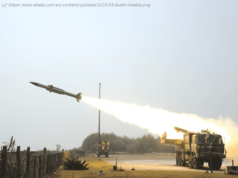Vladimir V. Putin’s plane crossed NATO airspace without clearance for about 50 seconds while flying from Russia to the meeting with President Trump, the Estonian military says.
MOSCOW — Even before his plane touched down in Finland for a summit meeting with President Trump, President Vladimir V. Putin of Russia, who was widely seen as coming out ahead at the meeting, had notched a victory in the air, the Estonian authorities say.
Estonia — small, vulnerable and at the northeastern rim of the North Atlantic Treaty Organization’s mutual security zone — has long been seen as a test case for the alliance’s willingness to resist Russian military moves.
For more than a decade, Russian military planes have regularly zipped through the edges of NATO airspace over the Baltic Sea off Estonia’s coast, in daring, high-stakes runs that taunt the alliance’s air defenses.
While flying from Russia to Finland on Monday morning, Mr. Putin’s presidential plane entered NATO airspace without clearance over a portion of the Baltic Sea that is often the site of Russian military jet fly-bys, the Estonian military said on Tuesday.
The Estonian authorities monitored the presidential flight through the country’s airspace on Monday and released a statement on the illegal border crossing on Tuesday. The flight was also recorded on publicly available flight tracking services.
Mr. Putin’s Ilyushin-96 airplane, en route from Moscow to Helsinki, Finland’s capital, passed through NATO airspace for about 50 seconds on Monday morning, said Roland Murof, a spokesman for the Estonian military. The plane crossed about 1.5 nautical miles, or 1.7 miles, into Estonian territory.
It flew with a transponder turned on but without having filed a flight plan or contacting Estonian air traffic control, as is required for both military and civilian aircraft, Mr. Murof said.
The Kremlin did not respond on Tuesday to questions about the flight path, including whether the entry into NATO airspace was intentional or pilot error.
The plane flew near Vaindloo, an Estonian island where Russian military and government planes frequently violate the airspace, raising alarms and rattling nerves, Estonian officials and analysts say. The island is a hot spot in the aerial games of chicken between Russia and NATO.
Planes, though, are welcome to pass through the area if they file flight plans and communicate with ground controllers. Russian planes cross the border without clearance about once every two months, Mr. Murof said.
The instances “go up when something political is going on,” Mr. Murof said, suggesting that the incursions are intended to send a message.
“It’s a long pattern that we’ve monitored throughout the years,” he said. “Events yesterday just showed on what level they were willing to carry this.”
He said two Russian government jets, including the presidential plane, flew to Finland on Monday, and it was not clear which plane carried Mr. Putin. Both crossed briefly into Estonian airspace.
Mr. Murof said it remained unclear why the presidential plane had passed through NATO airspace without clearance before the summit meeting.
The flight, he said, like the regular fighter-jet incursions in the same area, could have been intended as an opening statement of sorts for the meeting. It would demonstrate what the Russians see as NATO’s indecisiveness in the Baltic Sea.
“That’s one way of interpreting it, yes,” he said.
But Kadri Liik, a senior policy analyst with the European Council on Foreign Relations, cautioned that not all air border incursions in Estonia were politically hued. Russian military and government planes, she said, sometimes enter Estonian airspace “just to take a shortcut” across awkwardly shaped, post-Soviet airspace borders.
Air incursions picked up after the onset of the Ukraine crisis in 2014. President Barack Obama chose Estonia as the site for a speech offering reassurances of the alliance’s commitment to a common defense after the Russian military moves in Ukraine, to the south.
The airborne game of tag, usually played with fighter jets, underscores what analysts, and certainly many Russian officials, interpret as a vulnerability in that commitment.
It is known as an asymmetry of interests.
Russia is willing to take more risks. And NATO pilots who intercept Russian planes can set off flares and roll to show their weapons, but they do not shoot. That would risk a wider war with Russia over territory of little importance to the United States or most other NATO members — such as windswept Vaindloo.
Jets in any case would most likely not be scrambled for air border violations lasting less than a minute, as was the case with the presidential Ilyushin on Monday, Mr. Murof, the Estonian military spokesman, said.
“Most of these air border violations happen for only a minute, or two minutes maximum,” he said. “Yesterday’s event is characteristic of Russia’s behavior.”






